South India, where the tapestry of culture, history, and natural beauty is woven with threads of tradition and modernity, invites travellers to immerse themselves in its rich heritage and breathtaking landscapes. From the temple towns that echo the chants of millennia to the tranquil hill stations shrouded in mist, this region offers a journey through time and nature.
Chennai City
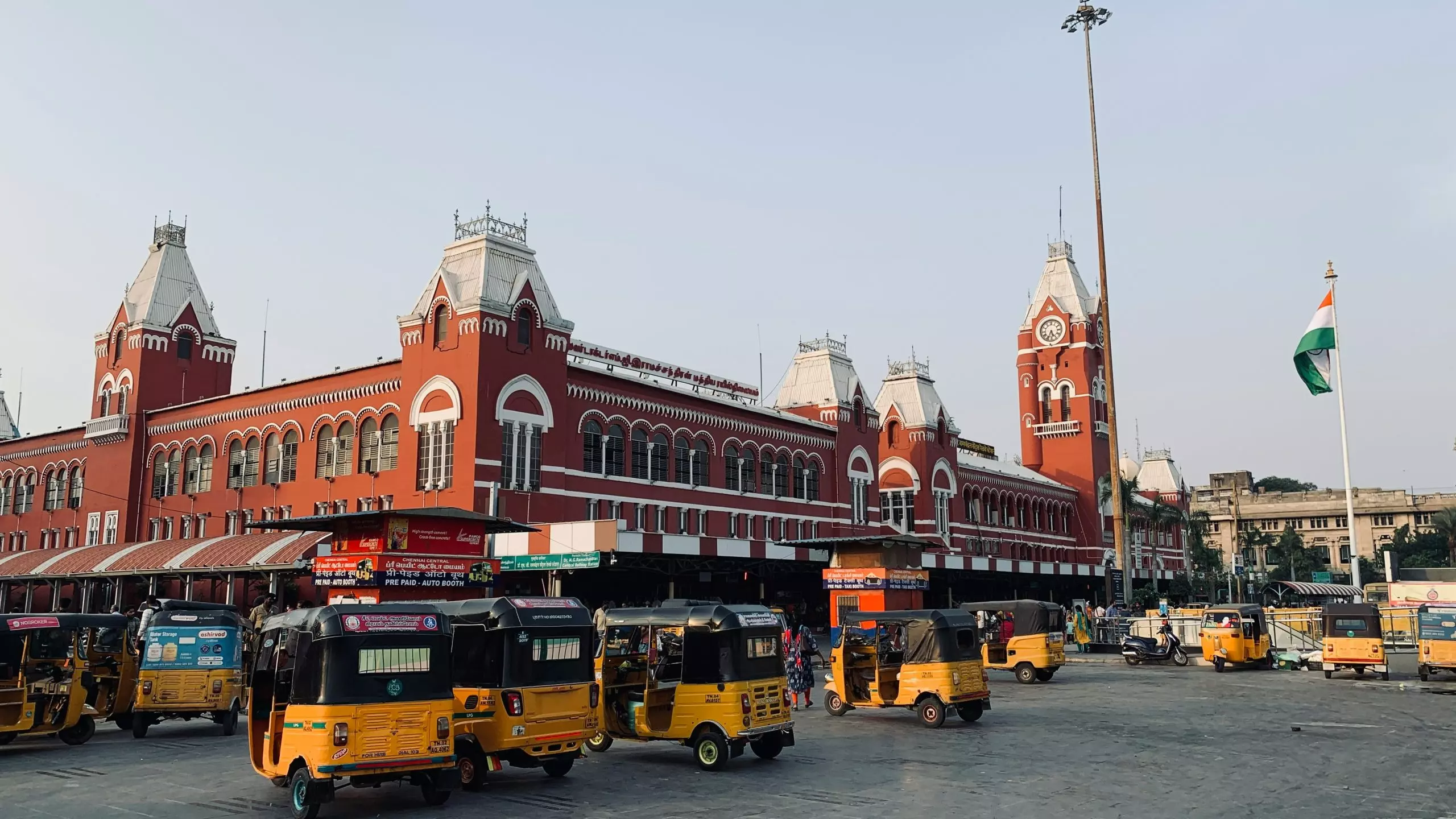 Historically known as Madras, Chennai holds a pivotal place in the annals of colonial India, serving as the cradle of British power in the subcontinent. Founded in 1639 when the British East India Company secured a strip of land to build Fort St. George under Francis Day’s and Andrew Cogan’s stewardship, the city emerged as the first significant settlement and the beating heart of British ambitions in India. This imposing fortress, now housing the Tamil Nadu Legislative Assembly, became the nucleus around which the modern city of Chennai developed. As the administrative and military hub of the British in the South, Chennai played a crucial role in expanding British influence, serving as a gateway for trade, culture, and governance. Fort St. George is the largest historical fort in the world, and St. Mary’s church is the oldest Anglican church east of Suez.
Historically known as Madras, Chennai holds a pivotal place in the annals of colonial India, serving as the cradle of British power in the subcontinent. Founded in 1639 when the British East India Company secured a strip of land to build Fort St. George under Francis Day’s and Andrew Cogan’s stewardship, the city emerged as the first significant settlement and the beating heart of British ambitions in India. This imposing fortress, now housing the Tamil Nadu Legislative Assembly, became the nucleus around which the modern city of Chennai developed. As the administrative and military hub of the British in the South, Chennai played a crucial role in expanding British influence, serving as a gateway for trade, culture, and governance. Fort St. George is the largest historical fort in the world, and St. Mary’s church is the oldest Anglican church east of Suez.
Architecture
 Chennai offers a diverse array of architectural wonders beyond the well-trodden path. The Central Railway Station, Egmore Railway Station, the High Court and the Government Museum in the Pantheon Complex blend British and Mughal architectural elements, making it a repository of history and architectural beauty. Its corridors whisper tales of the past, holding treasures that span centuries.
Chennai offers a diverse array of architectural wonders beyond the well-trodden path. The Central Railway Station, Egmore Railway Station, the High Court and the Government Museum in the Pantheon Complex blend British and Mughal architectural elements, making it a repository of history and architectural beauty. Its corridors whisper tales of the past, holding treasures that span centuries.
The city’s colonial legacy is etched in its architectural and cultural fabric, from the buildings along the Marina Beach promenade to the quaint by-lanes of George Town, each narrating stories of a bygone era. The Indo-Saracenic structures, such as the Madras High Court and the Chennai Central Railway Station, stand as testaments to a period of architectural fusion and imperial grandeur. Beyond architecture, the colonial influence permeates Chennai’s educational institutions, legal systems, and administrative frameworks, laying the foundations for the modern metropolis Chennai has become. This rich colonial heritage, coupled with its ancient roots, positions Chennai as a city where history is alive, offering a unique lens through which the layers of India’s past can be explored and appreciated.
Chennai, a city where tradition and modernity interlace, is a testament to India’s vibrant cultural mosaic. As the gateway to the South, this dynamic metropolis is steeped in a rich historical tapestry, from the serene Kapaleeshwarar Temple, with its Dravidian architectural splendour, to the colonial grandeur of Fort St. George, which narrates tales of India’s colonial past. The city’s coastline, crowned by the iconic Marina Beach, offers a breezy retreat from the urban hustle. The bustling streets, lined with a melange of markets, cafes, and cultural spaces, pulse with the energy of everyday life.
Dance and Culture
Chennai’s music and dance scene, particularly during the December Music Season, transforms the city into a cultural epicentre, showcasing classical Carnatic melodies and intricate Bharatanatyam performances that feast for the senses. The city’s culinary landscape, with its sumptuous South Indian fare, from fragrant filter coffee to the quintessential ‘masala dosa’, promises an authentic taste of Tamil Nadu’s rich gastronomic heritage. Chennai is not just a city to visit; it’s an experience that weaves together the threads of history, culture, and community into a vibrant tapestry, inviting exploration and discovery.
Chennai is the centre of the Indian IT industry, along with Bengaluru and Hyderabad. Thanks to being one of the states with the highest number of institutes for higher education, qualified labour is often easier to find than in the other two.
Valluvar Kottam – Poetry and Tamil Linguistic History
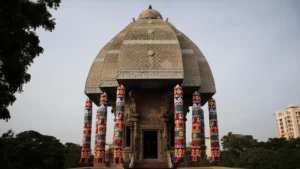 The Valluvar Kottam, a modern monument built between 1975 and 1976, pays homage to the revered Tamil poet Thiruvalluvar. Inspired by the ancient temple chariots, this chariot-shaped structure is an emblem of Tamil culture’s depth and vitality, standing proud in the city’s heart. Thiruvalluvar lived at the beginning of the first century, and his proverbs, known as Thirukkural, are critical elements in the development of the Tamil language, one of the oldest spoken languages in the world. All schoolchildren in Tamil Nadu still have to learn many of the Thirukkural verses by heart.
The Valluvar Kottam, a modern monument built between 1975 and 1976, pays homage to the revered Tamil poet Thiruvalluvar. Inspired by the ancient temple chariots, this chariot-shaped structure is an emblem of Tamil culture’s depth and vitality, standing proud in the city’s heart. Thiruvalluvar lived at the beginning of the first century, and his proverbs, known as Thirukkural, are critical elements in the development of the Tamil language, one of the oldest spoken languages in the world. All schoolchildren in Tamil Nadu still have to learn many of the Thirukkural verses by heart.
Under the Banyan Tree in the Theosophical garden
 Theosophical Society’s headquarters, set amidst the lush greenery of Adyar, is a serene retreat that houses a vast library and the striking 450-year-old Adyar Banyan Tree. Its buildings, blending Indian and colonial architectural elements, offer a tranquil space for contemplation amid the urban hustle.
Theosophical Society’s headquarters, set amidst the lush greenery of Adyar, is a serene retreat that houses a vast library and the striking 450-year-old Adyar Banyan Tree. Its buildings, blending Indian and colonial architectural elements, offer a tranquil space for contemplation amid the urban hustle.
Each of these structures, distinct in their architectural style and historical significance, contributes to the rich tapestry of Chennai’s skyline, offering myriad stories of the city’s evolution from a colonial outpost to a bustling metropolis, steeped in tradition yet forging ahead into the future.
Dakshina Chitra
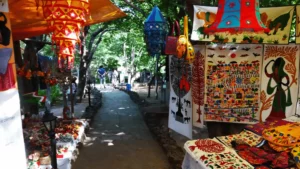 A stone’s throw from the bustling metropolis of Chennai, Dakshina Chitra serves as a vibrant portal into the soul of South India, offering a deep dive into its rich tapestry of cultures, traditions, and art. This meticulously curated living museum brings to life the diverse heritage of the southern states, showcasing traditional homes, artisans at work, and folk performances that paint a vivid picture of the region’s cultural ethos. Each exhibit tells a story, whether it’s the intricately carved doorways of Tamil Nadu, the ornate boats of Kerala, the colourful weaves of Andhra Pradesh, or the distinct terracotta of Karnataka.
A stone’s throw from the bustling metropolis of Chennai, Dakshina Chitra serves as a vibrant portal into the soul of South India, offering a deep dive into its rich tapestry of cultures, traditions, and art. This meticulously curated living museum brings to life the diverse heritage of the southern states, showcasing traditional homes, artisans at work, and folk performances that paint a vivid picture of the region’s cultural ethos. Each exhibit tells a story, whether it’s the intricately carved doorways of Tamil Nadu, the ornate boats of Kerala, the colourful weaves of Andhra Pradesh, or the distinct terracotta of Karnataka.
Dakshina Chitra celebrates the architectural and craft traditions of these regions and serves as a custodian of intangible heritage, preserving languages, customs, and lifestyles that are at risk of being overshadowed by modernity. A visit here is an enlightening journey that bridges past and present, offering a unique opportunity to experience the living traditions of South India in an immersive, engaging setting.
Religious tolerance and coexistence
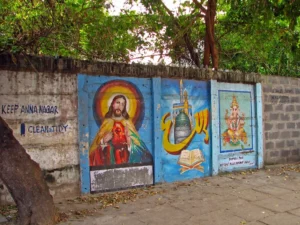 Beyond its Hindu and colonial heritage, Chennai also cradles a significant Christian legacy, deeply intertwined with the story of St. Thomas, one of the twelve apostles. According to tradition, St. Thomas arrived on the shores of Tamil Nadu in 52 AD, leaving an indelible mark on the region’s spiritual landscape. The numerous churches in Chennai bear witness to the profound influence of Christianity on the state. With its soaring spires, the San Thome Basilica stands as a majestic monument to this heritage, said to house the tomb of St. Thomas. This revered site and many other churches dotting the city speak volumes about Chennai’s diverse religious tapestry.
Beyond its Hindu and colonial heritage, Chennai also cradles a significant Christian legacy, deeply intertwined with the story of St. Thomas, one of the twelve apostles. According to tradition, St. Thomas arrived on the shores of Tamil Nadu in 52 AD, leaving an indelible mark on the region’s spiritual landscape. The numerous churches in Chennai bear witness to the profound influence of Christianity on the state. With its soaring spires, the San Thome Basilica stands as a majestic monument to this heritage, said to house the tomb of St. Thomas. This revered site and many other churches dotting the city speak volumes about Chennai’s diverse religious tapestry.
The city’s cosmopolitan fabric is further enriched by substantial communities of Muslims, Malayalees, and Telugus, each contributing their unique cultural and religious practices to its rich and diverse identity. This blend of cultures and faiths fosters a rich, inclusive atmosphere, making Chennai a melting pot of traditions, languages, and religious beliefs, where ancient traditions coexist seamlessly with modern-day cosmopolitanism. Photo McKay Savage
Safety in Chennai and Tamil Nadu
 Chennai stands out among India’s major cities for its low crime rates, offering unrivalled safety and security and fostering a tranquil urban environment. The city is also distinguished by its improved air quality, making it a beacon of environmental quality amidst the hustle and bustle of city life. Further enhancing urban life, the recent launch of the Chennai Metro has revolutionised the ease of travel within the city, providing a swift, convenient, and eco-friendly mode of transportation that weaves through the metropolis. This harmonious blend of safety, environmental stewardship, and cutting-edge infrastructure amplifies Chennai’s allure as a city that is not only forward-looking but also deeply liveable.
Chennai stands out among India’s major cities for its low crime rates, offering unrivalled safety and security and fostering a tranquil urban environment. The city is also distinguished by its improved air quality, making it a beacon of environmental quality amidst the hustle and bustle of city life. Further enhancing urban life, the recent launch of the Chennai Metro has revolutionised the ease of travel within the city, providing a swift, convenient, and eco-friendly mode of transportation that weaves through the metropolis. This harmonious blend of safety, environmental stewardship, and cutting-edge infrastructure amplifies Chennai’s allure as a city that is not only forward-looking but also deeply liveable.
Adding to its unique charm is the rich tapestry of Tamilian culture, where the sense of ethnic identity transcends religious or caste distinctions, fostering a remarkably harmonious and inclusive society. This deep-rooted cultural unity has fostered one of India’s most cohesive and flourishing communities, further enriching Chennai’s vibrant social landscape and contributing to its status as a model of cultural harmony and prosperity within India’s diverse mosaic.
Temple Country
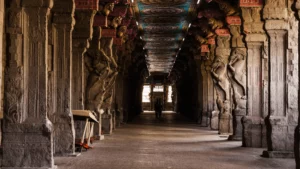 Tamil Hindu temples differ significantly from those in North India. Many are ancient and have stood up as monuments for millennia. The majestic Rock Fort Temple dominates Tiruchirappalli. This historic fortress stands sentinel on a rocky outcrop. The soaring gopurams of the Meenakshi Amman Temple dramatically punctuate Madurai’s skyline. This monument is a testament to the grandeur of Dravidian architecture and the profound depth of Tamil spirituality. This temple, a labyrinth of myth and majesty, not only dominates the city’s architectural landscape but also embodies the cultural soul of Tamil Nadu. Significantly, one of these iconic temple towers, renowned for its intricate carvings and vibrant sculptures, has been immortalised as the emblem in the state’s coat of arms. This symbolises the temple’s deep-rooted significance in the region’s heritage and its revered status as a central pillar of Tamil identity and spiritual life.
Tamil Hindu temples differ significantly from those in North India. Many are ancient and have stood up as monuments for millennia. The majestic Rock Fort Temple dominates Tiruchirappalli. This historic fortress stands sentinel on a rocky outcrop. The soaring gopurams of the Meenakshi Amman Temple dramatically punctuate Madurai’s skyline. This monument is a testament to the grandeur of Dravidian architecture and the profound depth of Tamil spirituality. This temple, a labyrinth of myth and majesty, not only dominates the city’s architectural landscape but also embodies the cultural soul of Tamil Nadu. Significantly, one of these iconic temple towers, renowned for its intricate carvings and vibrant sculptures, has been immortalised as the emblem in the state’s coat of arms. This symbolises the temple’s deep-rooted significance in the region’s heritage and its revered status as a central pillar of Tamil identity and spiritual life.
Tranquebar – A Danish spot in India
 Tranquebar, a magical slice of Denmark in India, captivates with its blend of tranquil seas and picturesque colonial architecture. Originally called Tharangambadi, meaning ‘land of the singing waves,’ this enchanting locale along Tamil Nadu’s Coromandel coast epitomises serenity with the soothing sounds of the Bay of Bengal. It became a Danish colony in the early 17th century when the Danes, struggling with the local pronunciation, renamed it Tranquebar. As a trading outpost alongside Serampore in West Bengal, it thrived under Danish control until it was sold to the British. The remnants of Danish influence are evident, most notably in the quaint fort overlooking the sea and the vibrant colonial buildings that dot the landscape, telling tales of a time when European powers vied for dominance in India.
Tranquebar, a magical slice of Denmark in India, captivates with its blend of tranquil seas and picturesque colonial architecture. Originally called Tharangambadi, meaning ‘land of the singing waves,’ this enchanting locale along Tamil Nadu’s Coromandel coast epitomises serenity with the soothing sounds of the Bay of Bengal. It became a Danish colony in the early 17th century when the Danes, struggling with the local pronunciation, renamed it Tranquebar. As a trading outpost alongside Serampore in West Bengal, it thrived under Danish control until it was sold to the British. The remnants of Danish influence are evident, most notably in the quaint fort overlooking the sea and the vibrant colonial buildings that dot the landscape, telling tales of a time when European powers vied for dominance in India.
Today, Tranquebar offers a unique historical experience, inviting visitors to explore its rich past through well-preserved sites. The Dansborg Fort, a small yet significant fortress, is a testament to Danish engineering and strategy on foreign shores. Alongside the fort, the town is sprinkled with various colonial-era structures, including churches and cultural centres that continue to serve the local community. For those interested in history and architecture, Tranquebar offers a glimpse into Danish colonial endeavours and provides a peaceful retreat away from the bustling urban centres, making it a perfect destination for those seeking cultural enrichment and relaxation by the sea.
Hill stations – British Summer residences and tea plantations
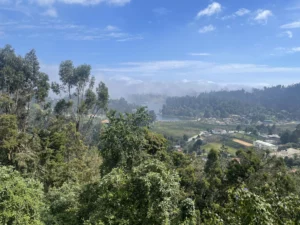 For those yearning to retreat into nature, the hill stations of Ooty, Kodaikanal, and Munnar are remnants of colonial escapism. The British established these locations as summer residences to escape the sweltering heat of the plains. Today, they continue to enchant visitors with their pristine landscapes and colonial heritage.
For those yearning to retreat into nature, the hill stations of Ooty, Kodaikanal, and Munnar are remnants of colonial escapism. The British established these locations as summer residences to escape the sweltering heat of the plains. Today, they continue to enchant visitors with their pristine landscapes and colonial heritage.
Ooty and Kodaikanal, nestled in the Western Ghats, are renowned for their picturesque tea gardens and quaint colonial-era bungalows. Ooty, often called the “Queen of Hill Stations,” boasts the famous Nilgiri Mountain Railway. This UNESCO World Heritage site meanders through stunning vistas of steep hills and eucalyptus forests. The railway is a relic of British engineering. It offers a nostalgic journey back in time as it winds through the emerald landscapes, providing a serene escape from the tropical heat.
Kodaikanal, known as the “Princess of Hill Stations,” captivates visitors with its serene lakes and cascading waterfalls. The town’s charming architecture and flower-filled parks reflect its colonial past, while modern-day Kodaikanal boasts vibrant markets that sell handmade crafts and organic produce.
Munnar, located in Kerala, adds another layer to the hill station experience with its unique blend of nature and culture. Historically significant, Munnar’s tea plantations date back to the late 19th century, when the British developed them. Today, these sprawling estates produce some of the finest tea in the world. The Eravikulam National Park, home to the endangered Nilgiri Tahr, is another gem of Munnar, offering opportunities to witness the region’s rich biodiversity. Photo Anders Stenbäck
Tea Production and Tribes
 The people of these Indian hill stations contribute to their charm. In Munnar, for instance, the local communities are involved in tea production, and their traditional practices and festivals add vibrancy to the visitor experience. The Indigenous tribes, such as the Todas in Ooty and the Paliyans in Kodaikanal, have rich cultural traditions that offer a glimpse into the area’s history beyond its colonial aspects.
The people of these Indian hill stations contribute to their charm. In Munnar, for instance, the local communities are involved in tea production, and their traditional practices and festivals add vibrancy to the visitor experience. The Indigenous tribes, such as the Todas in Ooty and the Paliyans in Kodaikanal, have rich cultural traditions that offer a glimpse into the area’s history beyond its colonial aspects.
Overall, South India’s hill stations are not just retreats but are gateways to exploring a unique blend of history, nature, and culture. Each station tells its own story, making them perfect destinations for those seeking solace in the lap of nature or a dive into the echoes of the past.
Wildlife – Tigers, Elephants, and jungles
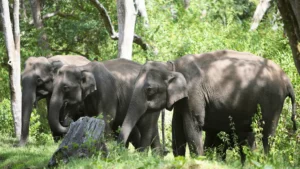
The rich tapestry of wildlife in South India extends beyond the well-known sanctuaries of Tamil Nadu to encompass a variety of habitats, each offering unique encounters with some of the subcontinent’s most iconic fauna. The wild heart of Tamil Nadu is indeed vibrant, with the dense forests of Mudumalai and Anamalai providing a sanctuary for numerous species.
Mudumalai National Park, situated at the tri-junction of Tamil Nadu, Karnataka, and Kerala, is a crucial part of the Nilgiri Biosphere Reserve. It is one of India’s first tiger reserves under the Project Tiger initiative. This sanctuary is teeming with wildlife, including Bengal tigers, Indian leopards, and various types of deer. Bird enthusiasts can also find a haven here, with over 250 species of birds documented, including the rare Malabar grey hornbill and the crested hawk-eagle.
Anamalai Tiger Reserve, also known as Indira Gandhi Wildlife Sanctuary, spans across Tamil Nadu and Kerala. It is home to significant populations of Indian elephants, which can often be seen near water bodies and in the open grasslands. The reserve’s varied terrain, ranging from grasslands to montane forests, supports a diverse array of flora and fauna, including the endangered lion-tailed macaque, Nilgiri langur, and Asian elephants. The area is also noted for its substantial bird population, making it a prime spot for birdwatching.
Wildlife Sanctuaries in the neighbouring states
Further south, in Kerala, the Periyar Wildlife Sanctuary stands out as a prominent ecological treasure. Nestled within the Western Ghats, it is renowned for its elephant populations and picturesque lake, around which the wildlife thrives. Visitors to Periyar can enjoy boat rides on the lake, which provide a unique vantage point for watching animals come to drink and bathe. In addition to elephants, the park is home to tigers, gaurs (also known as Indian bison), and more exotic species, such as the Malabar giant squirrel.
Karnataka’s Bandipur National Park, adjacent to Mudumalai, is another vital component of the Nilgiri Biosphere Reserve. Known for its significant tiger and elephant populations, Bandipur also supports a wide range of other species, including the Indian wild dog (dhole), which is often seen in dynamic social packs.
Each of these sanctuaries protects numerous species of mammals and birds, offering an array of experiences for nature lovers. From guided jungle safaris that provide the thrill of spotting a tiger in the wild to tranquil boat rides observing elephants along the shore, South India’s wildlife sanctuaries showcase the stunning biodiversity and beauty of the Indian wilderness, inviting explorers to immerse themselves deep into the realms of the untamed.
Mahabalipuram
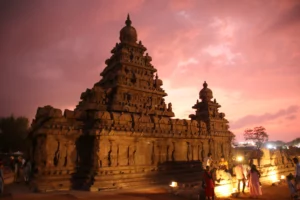 Nestled along the Coromandel Coast, near Chennai, lies Mahabalipuram, a historic sanctuary that whispers tales of ancient splendour and architectural marvel. This UNESCO World Heritage Site, with origins dating back to the 7th and 8th centuries, was the cradle of Dravidian architecture under the reign of the Pallava dynasty. Among its myriad wonders, the enigmatic Krishna’s Butterball defies gravity, captivating the imagination with its precarious balance.
Nestled along the Coromandel Coast, near Chennai, lies Mahabalipuram, a historic sanctuary that whispers tales of ancient splendour and architectural marvel. This UNESCO World Heritage Site, with origins dating back to the 7th and 8th centuries, was the cradle of Dravidian architecture under the reign of the Pallava dynasty. Among its myriad wonders, the enigmatic Krishna’s Butterball defies gravity, captivating the imagination with its precarious balance.
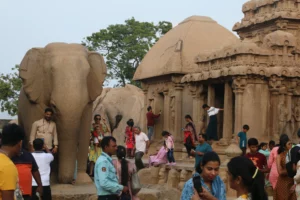 Remarkably, Mahabalipuram houses a rare temple dedicated to the three principal deities of Hinduism—Brahma, Vishnu, and Shiva—bridging the spiritual divide in a unique tribute to divine unity. The Shore Temple, with its dual shrines for both Vishnu and Shiva, stands as an architectural confluence, symbolising a harmonious coexistence seldom seen amidst the historical rivalry of their respective followers. Additionally, the site’s astonishing engineering prowess is vividly showcased in the creation of the Five Rathas, each carved from a single monolith, demonstrating an advanced understanding of stone craftsmanship and structural engineering. Visiting Mahabalipuram is not just a journey through India’s golden past; it’s an encounter with a civilisation that mastered the art of storytelling through stone, inviting one to ponder the enduring human spirit’s connection to the divine and the natural world.
Remarkably, Mahabalipuram houses a rare temple dedicated to the three principal deities of Hinduism—Brahma, Vishnu, and Shiva—bridging the spiritual divide in a unique tribute to divine unity. The Shore Temple, with its dual shrines for both Vishnu and Shiva, stands as an architectural confluence, symbolising a harmonious coexistence seldom seen amidst the historical rivalry of their respective followers. Additionally, the site’s astonishing engineering prowess is vividly showcased in the creation of the Five Rathas, each carved from a single monolith, demonstrating an advanced understanding of stone craftsmanship and structural engineering. Visiting Mahabalipuram is not just a journey through India’s golden past; it’s an encounter with a civilisation that mastered the art of storytelling through stone, inviting one to ponder the enduring human spirit’s connection to the divine and the natural world.
Beyond its rich historical tapestry, the village beckons with expansive beach resorts lining the coast, offering enthusiasts ample opportunities for surfing or leisurely swimming in the azure waters. Local fishermen haul in the day’s fresh catch, providing a taste of the sea’s bounty. For those inclined towards a more hands-on experience, there’s the chance to venture out to sea on traditional “katta marams”. Intriguingly, the word ‘catamaran’ traces its roots back to Tamil, referring to these sturdy yet straightforward rafts constructed from logs bound together with rope, offering a glimpse into the ingenuity of local maritime practices. Photos Anders Stenbäck
Pondicherry
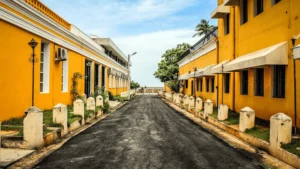 While technically outside the borders of Tamil Nadu, Pondicherry (Puducherry), a mere stone’s throw away, holds a distinct and captivating allure. With its well-preserved colonial architecture and chic French Quarter, this former French colony paints a picture of a bygone era where French boulevards and Tamil culture create a picturesque setting, where streets are lined with charming boutiques, heritage buildings, and fragrant bakeries, leading to serene beaches that offer a tranquil escape from the everyday.
While technically outside the borders of Tamil Nadu, Pondicherry (Puducherry), a mere stone’s throw away, holds a distinct and captivating allure. With its well-preserved colonial architecture and chic French Quarter, this former French colony paints a picture of a bygone era where French boulevards and Tamil culture create a picturesque setting, where streets are lined with charming boutiques, heritage buildings, and fragrant bakeries, leading to serene beaches that offer a tranquil escape from the everyday.
Pondicherry’s French legacy extends beyond its architecture and urban layout. It has profoundly influenced the local culture, cuisine, and language, creating a unique socio-cultural tapestry that is palpable to every visitor. The remnants of French rule are most visible in the French Quarter, where the streets bear French names, and the police don traditional kepis.
The spiritual heart of Pondicherry is the Sri Aurobindo Ashram, a renowned spiritual community founded by Sri Aurobindo and The Mother. The Ashram attracts seekers from across the globe, drawn to its teachings of integral yoga and its serene atmosphere. The Ashram’s influence extends to the experimental township of Auroville, envisioned as a universal town where people of all nationalities live harmoniously.
Botanical Garden
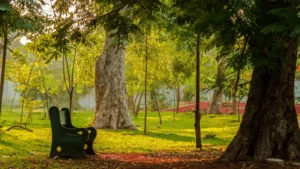 Another gem in Pondicherry’s crown is the Botanical Garden, a lush oasis that showcases an array of exotic flora. This garden gained international fame through its association with Yann Martel’s bestselling novel The Life of Pi and the subsequent film adaptation, which depicted the protagonist’s early life amidst the garden’s enchanting landscape. This connection has added a layer of literary and cinematic allure to the garden, making it a must-visit for fans and nature lovers.
Another gem in Pondicherry’s crown is the Botanical Garden, a lush oasis that showcases an array of exotic flora. This garden gained international fame through its association with Yann Martel’s bestselling novel The Life of Pi and the subsequent film adaptation, which depicted the protagonist’s early life amidst the garden’s enchanting landscape. This connection has added a layer of literary and cinematic allure to the garden, making it a must-visit for fans and nature lovers.
Pondicherry, with its blend of French colonial history, spiritual heritage, and botanical wonders, offers a multifaceted experience that transcends the typical tourist itinerary, making it a cherished destination for those seeking to immerse themselves in a rich cultural and historical narrative.
Kerala
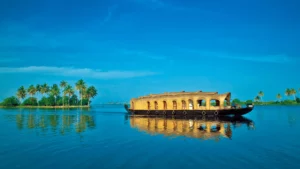 Beyond Tamil Nadu, Kerala unfolds like a verdant carpet along the Malabar Coast, with its labyrinthine backwaters, swaying palm groves, and spice-scented highlands. The tranquillity of Alleppey’s backwaters, Thekkady’s exotic wildlife, and Munnar’s mystical hills create a diverse palette of experiences, blending relaxation with adventure.
Beyond Tamil Nadu, Kerala unfolds like a verdant carpet along the Malabar Coast, with its labyrinthine backwaters, swaying palm groves, and spice-scented highlands. The tranquillity of Alleppey’s backwaters, Thekkady’s exotic wildlife, and Munnar’s mystical hills create a diverse palette of experiences, blending relaxation with adventure.
Kerala, often referred to as ‘God’s Own Country’, is a state in southwestern India renowned for its enchanting backwaters, lush green landscapes, and aromatic spice plantations. The tranquil backwaters of Alleppey and Kumarakom offer serene boat cruises, presenting a unique way to experience the state’s rustic beauty and vibrant village life. Kerala’s rich cultural heritage is showcased in its classical dance forms, such as Kathakali and Mohiniyattam, as well as in its festivals and temple architecture.
With their biodiverse rainforests, the Western Ghats house exotic wildlife sanctuaries such as Periyar and Wayanad, making Kerala a haven for nature enthusiasts. Moreover, the state’s age-old Ayurvedic traditions offer rejuvenating wellness experiences, drawing visitors seeking holistic health and relaxation. Kerala’s cuisine, characterised by coconut and spices, provides a flavourful culinary journey, adding to the myriad experiences that make this state a mosaic of natural and cultural treasures.
Andaman Island
 Off the mainland, the Andaman and Nicobar Islands emerge from the azure depths of the Bay of Bengal. Their untouched beaches and vibrant coral reefs offer a paradise for divers, nature lovers, and those seeking solace on their sun-kissed shores.
Off the mainland, the Andaman and Nicobar Islands emerge from the azure depths of the Bay of Bengal. Their untouched beaches and vibrant coral reefs offer a paradise for divers, nature lovers, and those seeking solace on their sun-kissed shores.
As a much less costly and more preserved alternative to the Maldives, the Andaman and Nicobar Islands, an archipelago of over 300 islands in the middle of the Bay of Bengal, are a slice of paradise known for their pristine beaches, clear turquoise waters, and lush tropical rainforests. Renowned for its vibrant coral reefs and rich marine life, these islands offer unparalleled snorkelling and scuba diving experiences. The Cellular Jail in Port Blair, a historic site, narrates tales of India’s freedom struggle, adding depth to the natural beauty. Accessible from Chennai, which serves as a primary gateway, these islands are a favoured destination for those seeking a blend of serene natural beauty and a glimpse into India’s poignant history. The journey from Chennai to this archipelago promises an escape into an enchanting world where nature’s wonders coexist harmoniously with historical narratives.
Sri Lanka
 Though not a part of India, Sri Lanka is merely an hour’s flight from Chennai. European tourists can acquire a visa on arrival at the Colombo Airport. This island emerges as a tropical haven adorned with mountains, jungles, tea plantations, and pristine beaches that offer surfing, snorkelling, and diving opportunities. Here, one can indulge in a vast array of global cuisines. Sri Lanka is highly accessible and presents a unique blend of Indian and Thai characteristics, yet it remains less commercialised and more affordable than Thailand.
Though not a part of India, Sri Lanka is merely an hour’s flight from Chennai. European tourists can acquire a visa on arrival at the Colombo Airport. This island emerges as a tropical haven adorned with mountains, jungles, tea plantations, and pristine beaches that offer surfing, snorkelling, and diving opportunities. Here, one can indulge in a vast array of global cuisines. Sri Lanka is highly accessible and presents a unique blend of Indian and Thai characteristics, yet it remains less commercialised and more affordable than Thailand.
Sri Lanka, often dubbed the “Pearl of the Indian Ocean,” offers a vibrant tapestry of cultural and natural wonders, making it a must-visit destination for travellers seeking an immersive experience. The island’s rich history is displayed through its ancient ruins, such as those at Sigiriya, an ancient rock fortress, and the sacred city of Anuradhapura, which provide insights into a civilisation that dates back over two millennia. The cultural festivals, full of colour and life, showcase the diverse heritage of the Sinhalese, Tamil, and various other ethnic groups, enriching the tourist experience with their unique customs and cuisines.
Additionally, Sri Lanka’s natural landscapes are breathtakingly diverse. From the misty heights of the Central Highlands to the lush rainforests of Sinharaja, the country is a haven for nature lovers and adventure seekers alike. Wildlife enthusiasts can explore national parks such as Yala and Wilpattu, where leopards, elephants, and numerous bird species are commonly found. The beaches, such as those at Unawatuna, Hikkaduwa, and Mirissa, offer serene spots ideal for relaxation, as well as bustling locales where activities like whale watching, surfing, and diving captivate the more adventurous. This blend of cultural richness and natural beauty, with its affordability and accessibility from nearby regions, makes Sri Lanka an enticing destination for a broad spectrum of travellers.
Visiting South India
Many destinations in South India are truly worth visiting. However, some regions are less accessible and explored than more frequented locales like Thailand, and traffic can be pretty heavy in the larger cities. While arranging travel in South India by air, train, bus, or car, along with booking accommodations, is relatively straightforward and can be done online, the journey can be more demanding. Nonetheless, the rewards are substantial. South India offers spectacular scenery, a rich historical tapestry, and encounters with friendly and fascinating locals.
This rich mosaic of destinations across the southern peninsula of India presents a canvas where every stroke tells a story, every hue reflects a tradition, and every landscape inspires awe. South India is a compelling chapter in the grand narrative of the Indian subcontinent. We have a separate page with more practical information you may want to know before visiting India.
Photos: Anders Stenbäck, McKay Savage, Public Domain